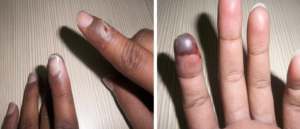Image type: Ischemic -Vasculitis thrombosis
Body site: Fingers
Description: Thromboembolic disease is increasingly recognized in systemic vasculitis, particularly with venous thrombotic events (VTEs) in Behçet’s disease and ANCA-associated vasculitis (AAV). This rise in VTEs has significant clinical implications due to the associated morbidity and mortality. The interaction between inflammation, vessel damage, and endothelial biology in vasculitis provides a model to explore the link between inflammation and thrombosis, potentially leading to new biomarkers and therapeutic targets.
Causes and symptoms: Ischemic vasculitis thrombosis often arises from structural vessel abnormalities caused by various vasculitides. In large and medium vessel vasculitis, thrombosis can lead to stenosis and occlusion. ANCA-associated vasculitis (AAV) and Behçet’s disease show an elevated risk of venous thromboembolic events (VTEs). In AAV, thrombosis is frequently associated with active disease phases, while in Behçet’s disease, there is a correlation between thrombus inflammation and the vessel wall. The exact relationship between thrombosis and vasculitis, including the role of specific risk factors, remains not fully understood. Key factors contributing to thrombosis include systemic vasculitis (such as AAV, Behçet’s disease, and giant cell arteritis), chronic inflammation that damages blood vessels, structural abnormalities in vessel walls, and increased disease activity exacerbating the risk.
Diagnosis: Diagnosis of ischemic vasculitis thrombosis involves several key steps. First, a clinical evaluation is conducted to assess symptoms and medical history, with particular attention to any signs of vasculitis. Imaging techniques such as ultrasound, CT scans, or MRI are then used to visualize the thrombus and evaluate vessel damage. Laboratory tests are performed to check for markers of inflammation and coagulation abnormalities. In some cases, a biopsy of affected tissue may be required to confirm the diagnosis and assess the extent of vasculitis.
Treatment: Physicians should monitor vasculitis patients for thrombosis, especially during active disease, but routine screening for asymptomatic individuals is not advised. The effectiveness of prophylactic antiplatelet or anticoagulant therapy, as well as the optimal duration of treatment for VTE in vasculitis, remains unclear. Research into thrombosis and inflammation in vasculitis may enhance understanding and treatment options. Inflammatory thrombosis is common in autoimmune diseases like Behçet’s syndrome, ANCA-associated vasculitis, and giant cell arteritis during active phases. Treatment typically involves corticosteroids or immunosuppressants to control vasculitis, along with anticoagulants or antiplatelet agents to manage clotting. Therapy should be customized based on disease activity to reduce thrombosis risk, and addressing symptoms like pain, swelling, and organ dysfunction through appropriate interventions is crucial.

You must be logged in to post a comment.